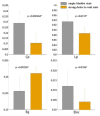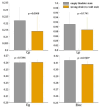Brain Responses Difference between Sexes for Strong Desire to Void: A Functional Magnetic Resonance Imaging Study in Adults Based on Graph Theory
- PMID: 39124552
- PMCID: PMC11313296
- DOI: 10.3390/jcm13154284
Brain Responses Difference between Sexes for Strong Desire to Void: A Functional Magnetic Resonance Imaging Study in Adults Based on Graph Theory
Abstract
Background: The alternations of brain responses to a strong desire to void were unclear, and the gender differences under the strong desire to void remain controversial. The present study aims to identify the functional brain network's topologic property changes evoked by a strong desire to void in healthy male and female adults with synchronous urodynamics using a graph theory analysis. Methods: The bladders of eleven healthy males and eleven females were filled via a catheter using a specific infusion and withdrawal pattern. A resting-state functional magnetic resonance imaging (fMRI) was performed on the enrolled subjects, scanning under both the empty bladder and strong desire to void states. An automated anatomical labeling (AAL) atlas was used to identify the ninety cortical and subcortical regions. Pearson's correlation calculations were performed to establish a brain connection matrix. A paired t-test (p < 0.05) and Bonferroni correction were applied to identify the significant statistical differences in topological properties between the two states, including small-world network property parameters [gamma (γ) and lambda (λ)], characteristic path length (Lp), clustering coefficient (Cp), global efficiency (Eglob), local efficiency (Eloc), and regional nodal efficiency (Enodal). Results: The final data suggested that females and males had different brain response patterns to a strong desire to void, compared with an empty bladder state. Conclusions: More brain regions involving emotion, cognition, and social work were active in females, and males might obtain a better urinary continence via a compensatory mechanism.
Keywords: brain–bladder control; desire to void; graph theory; resting-state functional magnetic resonance imaging; small-world network; topologic properties.
Conflict of interest statement
The authors declare that the research was conducted without any potential conflict of interest.
Figures





Similar articles
-
Brain functional network alterations caused by a strong desire to void in healthy adults: a graph theory analysis study.Neurourol Urodyn. 2020 Sep;39(7):1966-1976. doi: 10.1002/nau.24445. Neurourol Urodyn. 2020. PMID: 32806881
-
A resting-state functional MRI study on central control of storage: brain response provoked by strong desire to void.Int Urol Nephrol. 2015 Jun;47(6):927-35. doi: 10.1007/s11255-015-0978-0. Epub 2015 Apr 28. Int Urol Nephrol. 2015. PMID: 25917482
-
[Construction and analysis of functional network of hemi-brain in patients with brain tumors before and after anesthesia based on resting-state functional magnetic resonance imaging].Zhonghua Yi Xue Za Zhi. 2023 Jan 17;103(3):186-191. doi: 10.3760/cma.j.cn112137-20220519-01112. Zhonghua Yi Xue Za Zhi. 2023. PMID: 36649989 Chinese.
-
Association of aberrant structural-functional network coupling with cognitive decline in patients with non-dialysis-dependent stage 5 chronic kidney disease.Quant Imaging Med Surg. 2023 Dec 1;13(12):8611-8624. doi: 10.21037/qims-23-295. Epub 2023 Nov 17. Quant Imaging Med Surg. 2023. PMID: 38106236 Free PMC article.
-
Associations of the Disrupted Functional Brain Network and Cognitive Function in End-Stage Renal Disease Patients on Maintenance Hemodialysis: A Graph Theory-Based Study of Resting-State Functional Magnetic Resonance Imaging.Front Hum Neurosci. 2021 Dec 13;15:716719. doi: 10.3389/fnhum.2021.716719. eCollection 2021. Front Hum Neurosci. 2021. PMID: 34966264 Free PMC article.
References
-
- Abrams P., Cardozo L., Fall M., Griffiths D., Rosier P., Ulmsten U., van Kerrebroeck P., Victor A., Wein A. The standardisation of terminology of lower urinary tract function: Report from the Standardisation Sub-committee of the International Continence Society. Am. J. Obstet. Gynecol. 2002;187:116–126. doi: 10.1067/mob.2002.125704. - DOI - PubMed
-
- Rosier P.F.W.M., Schaefer W., Lose G., Goldman H.B., Guralnick M., Eustice S., Dickinson T., Hashim H. International Continence Society Good Urodynamic Practices and Terms 2016: Urodynamics, uroflowmetry, cystometry, and pressure-flow study. Neurourol. Urodyn. 2017;36:1243–1260. doi: 10.1002/nau.23124. - DOI - PubMed
Grants and funding
LinkOut - more resources
Full Text Sources
Miscellaneous

